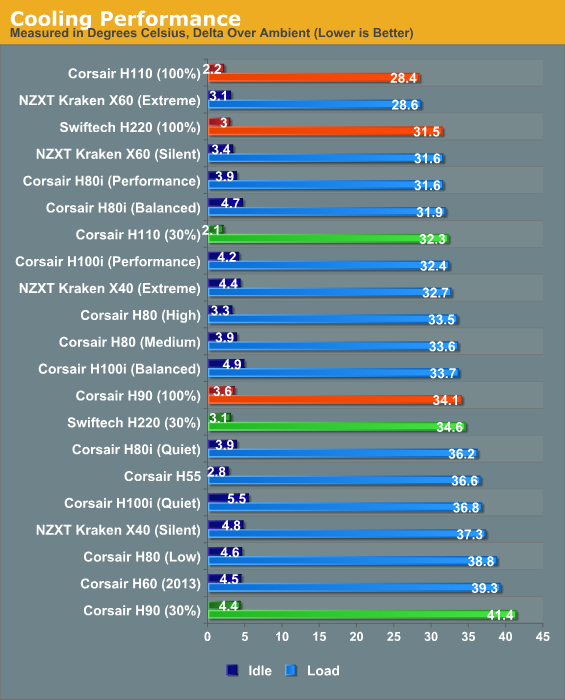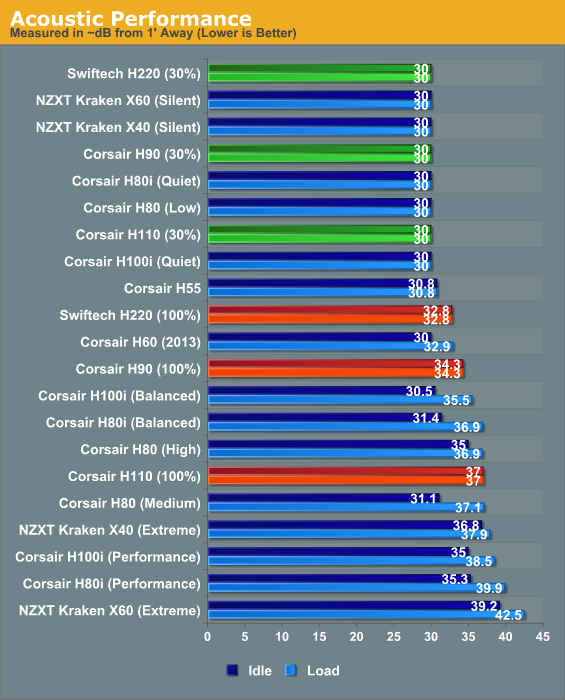Closing the Loop II: New Liquid Coolers from Corsair and Swiftech
by Dustin Sklavos on February 1, 2013 12:01 AM EST- Posted in
- Cases/Cooling/PSUs
- Corsair
- radiator
- Swiftech
Performance Results
I mentioned in the introduction that the new Corsair radiators are operating off of the same OEM hardware as NZXT's resident 140mm-based radiators. What I didn't mention was that Corsair doesn't have any software control for the fans or even any allowances made towards connecting and controlling the fans at all beyond the conventional motherboard headers. Corsair needs to hope the fans used on their H90 and H110 are enough to differentiate them from NZXT's Kraken series.
Swiftech, meanwhile, also uses PWM control, but includes a breakout block with the H220 to connect as many as seven different fans to a single PWM channel. It's worth noting, too, that though the Swiftech H220 is a 240mm radiator (like the Corsair H100i), the building materials and pump are almost completely different. The pump uses Swiftech's own secret sauce, while the radiator uses brass and copper instead of the garden variety aluminum the other radiators use. On top of this, they're using their own fans. Suffice to say, it's going to be interesting to see if the H220 can prove the extra effort and higher quality components are worthwhile.

Whether it's Corsair, NZXT, or good old-fashioned Asetek, the results don't lie: the 280mm radiator is just plain more efficient than any smaller block. Swiftech's H220 puts in a reasonably strong showing, though interestingly it has trouble overtaking the Corsair H80i at higher speeds. There's a very good reason for that, though, and you'll see it in a second.
Meanwhile, Asetek's single 140mm radiator basically continues to be a bust. It's by no means a terrible product, but the H90 and Kraken X40 are both pretty underwhelming. A thicker 120mm radiator with two fans continues to be a comparable if not superior choice.

If the Swiftech H220's performance is a little underwhelming, this is why. The H220 itself is definitely a strong radiator, but Swiftech clearly tuned their fans for acoustics instead of performance. At 30% fan speed only the X60 and H110 can offer both better thermal performance and fan speed, but at 100% fan speed, the louder, more aggressive fans are just able to push more cool air through their respective radiators.
What must be kept in mind is that while the H220 isn't necessarily blowing up the charts, the noise levels and thermal performance need to be connected and placed in context. The H220 is able to deliver competitive performance at lower noise levels than the competing radiators, and really only has to worry about the Corsair H110 and Kraken X60 beating it. Both of those are much harder to fit into most cases, too, a problem the Swiftech H220 doesn't have.










53 Comments
View All Comments
lowlymarine - Friday, February 1, 2013 - link
Still, I can't help but feel it would be worthwhile to include a couple of the more popular air coolers as well for comparison. The Noctua NH-D14 and Cooler Master Hyper 212+ are very popular units, and in the case of the former runs around the same price as some of the mid-range closed loop options. I think it would be illuminating to see how these options stack up against each other, for situations where clearance and so forth aren't major concerns.Dustin Sklavos - Friday, February 1, 2013 - link
I'll get there. :)Ratman6161 - Monday, February 4, 2013 - link
I recently replaced my Hyper 212+ with the H55 so I can sort of make that comparison. I'm running an i7-2600K@4.4Ghz so a fairly similar setup to the test rig in the article. With the 212+ I used to idle at 32 - 35 C and peak out at about 65 C running Intel Burn Test. With the H55 I idle at about 24 and the peak under load is around 53 - 55. But....I've made other changes too. With the liquid cooler I turned the my three 120 mm intake fans and case's 140 mm exhaust down to their minimum speeds and put the variable speed fan from the 212+ on the H55 in place of the constant speed fan that came with it.The 120 mm intakes and the fan off the 212+ that's now on the H55 are all bios controlled and set to run at their minimum speeds unless the CPU temp goes over 50 C. However that condition is never met (i.e. it never does go over 50 C) unless I'm deliberately ramping things up with Intel Burn Test. FYI my goal is always the best overclock I can get with stock voltage. I don't get any better overclock than I did with the 212+ but it does run cooler and quieter due to all the fans now able to run at minimum speed basically all the time. Since I don't turn up voltage, something better than the H55 probably would not do any good in my particular circumstances and what I've basically achieved over the 212+ was a quieter system.
TreXor - Wednesday, February 6, 2013 - link
53° C at full load with a 4.4 GHz overclocked i7-2600 on a H55? lol...Its time that you and all the other people that post ridiculous temps learn what programs to use to read out the real core temperatures. And its definitely not the software coming with your motherboard, reading out the CPU sensor in the socket...
althaz - Monday, February 4, 2013 - link
Yeah, this is a great review, but it's mostly useless data without including good air coolers for comparison. Especially the Noctua NH-D14 (which is probably not the best anymore, but from what I've seen still offers superior performance per decibel to most closed-loop water coolers).From Dustin's comments it seems we can expect some more stuff in the future, which will make this excellent review much more useful.
Jambe - Friday, February 1, 2013 - link
Ah, Swiftech, makers of those eccentric heavy slabs of copper studded with helicoid aluminium pins. Nice to see them making new & competent products.drfish - Friday, February 1, 2013 - link
Lol, was thinking that same thing. Now THAT would make for a great read, all of the classic coolers over the years pitted against each other - mounting all of them "unconventionally" shouldn't be that hard, right? ;)maratus - Sunday, February 3, 2013 - link
Actually, Swiftech has gone full-H2O after that and was always high-regarded amongst watercooling enthusiasts. Ever since Swiftech Storm was introduced, they became a major source of high-quality CPU and universal GPU waterblocks for custom builds. They also are the biggest reseller of Laing pumps and offer exclusive PWM-controlled version of DDC. MCR rads were the best in their price range for low noise fans and it's nice to see all-in-one kits as they have much more potential customers. I just hope that Swiftech will be more like Asetek in future and less like DangerDen, if you know what I mean.jasonelmore - Monday, August 12, 2013 - link
it was taken off the market due to patent infringements. gabe used someone else's design.Aikouka - Friday, February 1, 2013 - link
Dustin, with the following statement..."The H220 itself is definitely a strong radiator, but Swiftech clearly tuned their fans for acoustics instead of performance."
...it sounded like you were faulting the fans on the H220 as the main reason why the H220 can't compete with the other offerings. Out of curiosity, would you be willing to try different fans on it to see it that helps? Obviously, those numbers wouldn't be able to be used in any official context, but it would be interesting to see!
Although, I will admit that the idea of suggesting ponying up another $12-25 per fan (Enermax Magma, Noctua PF-12, etc.) to make an already expensive product work better is a bit ballsy of a marketing tactic! ;)